Curated Playlist: Finding Interstitials in the Television Archive
Jasmijn Van Gorp, Utrecht University
Introduction
Interstitials, be it promos, commercials or trailers, are literal bits between two programmes, making up a true treasure trove for television historical research. As Ellis (2011) puts it, interstitials function as ‘user guides’ in how broadcasters envisioned TV consumption by viewers in a given moment. Johnson (2012) illustrates the latter in her own research on branding UK and US television and points out how channels branded themselves, in addition to raising revenues through commercials and providing continuity techniques through interstitials. In this curated playlist, I show that interstitials not only are a treasure trove to shed light on scheduling and branding: they also prove useful for archive studies. I will elaborate this point by showing how researching interstitials can play a role in the understanding of the workings of broadcast archives and its metadata.
Interstitials can be seen as the epitome of what Polan (2013: 347) calls ‘forgettable’ television: “programming designed to be forgotten at virtually the very moment of its original viewing”, therefore rendering them vastly under-researched. Traditionally television historical accounts and broadcast archives alike used to be focused on the programmes rather than the bits between the programmes. Consequently the majority of interstitials were never saved or made accessible for research. Yet in the (rare) case of saved interstitials, Johnson (2012) noticed large numbers of interstitial data due to their inherent briefness.
For this research project I delved into the television collection [1] of the Netherlands Institute for Sound and Vision to probe interstitials of Dutch public broadcasters. Not only did I set out to investigate the different types of interstitials, I additionally (and especially) wanted to elaborate on how to find them. This research quest resulted in a non-exhaustive typology of interstitials in the archive, of which I singled out some of the most fascinating examples [2] that encompass this curated playlist.
This curated playlist therefore has a double function:
-
It is first and foremost a search guide for users with an interest in the collection of Interstitials at the Netherlands Institute for Sound and Vision. It informs users of the Media Suite on relevant search strategies to probe interstitials. In order to reproduce the query and my search paths, I saved the settings for all my queries and embedded them in my curated playlist. As more items are added to the collection on a daily basis, these embedded queries enable reproducibility regardless of the size of the collection. This, however, does mean that the number of results may have increased compared to the numbers mentioned in this playlist.
-
Moreover, it is the appendix of the book chapter “Interstitial Data: Tracing Metadata in Search Systems” (Van Gorp, 2022), in which I outline a method to investigate the role of metadata in search systems. In this curated playlist, I shed light on the elements that are left out of the book chapter: the interstitials themselves, their television historical context and my search paths (saved queries) that led me to them. A printed publication does not allow to play-out clips, and does not include research documentation. This curated playlist fills in this gap.
Please note:
-
Due to copyright restrictions, the videos are not embedded in this playlist. To watch the clips, you have to login with a Dutch university account and follow the links to the play-out tool (i.c. the Resource Viewer) in the Media Suite.
-
The videos are in Dutch and have no English-language subtitles. The metadata can be translated by installing a googletranslate plug-in. For more instructions for English-language readers, consult this tutorial .
-
I included more clips in this curated playlist than in the book chapter. Clips that are included in the book chapter are indicated with *.
Acknowledgements
This curated playlist is made in the context of the courses Data as Media and Television History Online at Utrecht University, and for workshops in the context of the CLICK-NL project Re-Frame .
Category 1: Leaders
One of the most challenging parts of this research was to get to grips with the different categorizations of interstitials in the archive. Most types of interstitials are colloquially known and spoken of through terms in the English language (e.g. leader, commercial) while the archive is essentially Dutch-language based. In addition, some specific terms do not have Dutch translations at all (i.c. interstitial and ident). Language aside, genre definitions and genres by itself are considered as cultural constructions in our field of media and cultural studies. Rather than setting my own definitions I explore how the archive categorizes the interstitials.
Throughout my research, the overlapping categories of promos and leaders were difficult to find and to understand, as these were quite ambiguous in the archive. The Netherlands Institute for Sound and Vision, for instance, has a Wiki Page on Leaders but lacks a page on Promovideos. However, in the archive itself the genre tag ‘Promo’ is preferred over the genre tag ‘Leaders’.
Let’s first explore the genre tag ‘Promos’. I located 315 promovideos with this genre tag in the television archive. This collection mainly consists of a compilation of leaders of the year 2010 for each channel and broadcaster, approximately 135 in total. Of these 135 videos, I single out a promo of the Digital Platform Uitzending Gemist . It shows a moving split screen of about 20 clips. The video zooms in on three clips for various programmes which are also interstitials, i.c. trailers with a voice-over). The promo ends with the URL: “Watch on uitzendinggemist.nl” (<Kijk op uitzendinggemist.nl). I chose this promo for my curated playlist, as it digitally mimics the linear channel mozaiek tv , a channel for analogue (cable) television on which viewers could simultaneously see what is broadcast at the different channels.
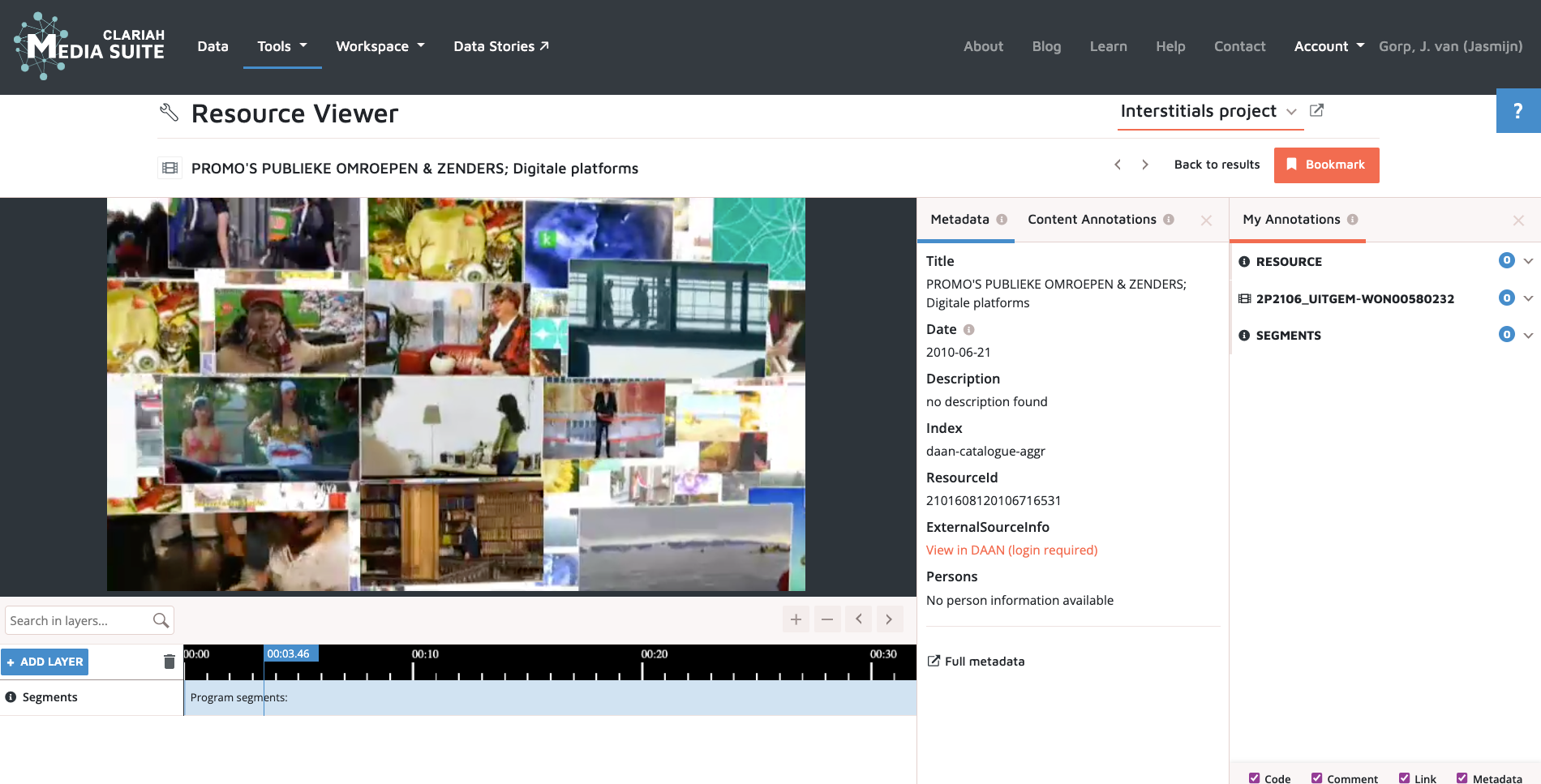
Screenshot of Leader Uitzending Gemist, showing a mosaic as known from analogue television (NPO, 2010): link to video (login required)
In order to find more leaders, the most straightforward option is to search for ‘Leader’ in all metadata fields . This search query encompasses all results in which ‘leaders’ are mentioned. At first sight, many of the items in English are part of the “Internationale Nieuwsuitwisseling” mentioning ‘leaders’ to refer to politicians. I excluded these items by querying for Leader NOT International which still yields almost 60.000 results.
The question then is how one can find interesting leaders in a subcollection of 60.000 leaders in total. I decided to select the news genre , as I anticipate many leaders of news to be archived since its high reuse value. On the first page, several titles catch the attention: the items labeled as “Weekly news”. As “Weekly news” contrasts with the general assumption that news is “Daily News”, I decided to select one Weekly News item to investigate it closely. I learnt that these weekly news items were made for the hearing impaired. In the following step, I tried to find out why the items are retrieved as they neither have the genre tag leader nor promo, nor mention ‘leader’ in their titles or descriptions. As I discuss in my book chapter, the items are retrieved because one of their reels is named ‘Leader’, which are accessible via de Resource Viewer’s playlist (see Screenshot).
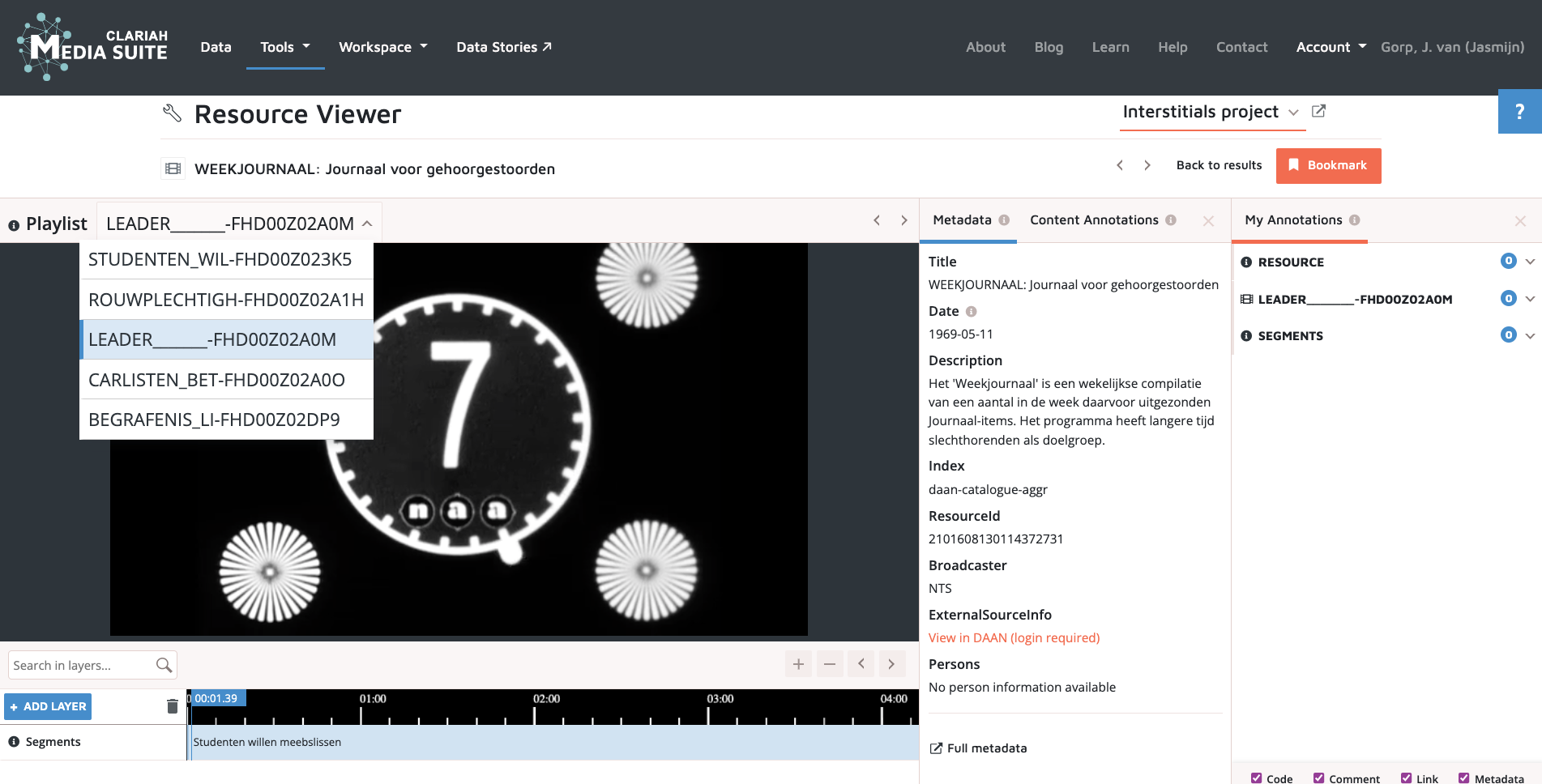
Screenshot Weekly News (NTS, 1969) which shows ‘leader’ as title of a reel: Link to video* (login required).
When I go back to the large collection of 60.000 leaders, my attention was also caught by Leaders Avondje AVRO . In the English language, this kind of leader for a station would be rather referred to as “Ident”, which is short for Station Identification.[3] The archive does not have the genre label Ident nor uses Ident in titles or descriptions.
Leaders Avondje AVRO is a tape with a collection of 1970s AVRO clips of all kinds of happy families in their home. This footage of families watching television is not unique for the Netherlands as Johnson (2012) found the same kind of interstitials for the channel ABC. She discusses in her book how these interstitials about ‘happy domestic life’ were typical for the late 1970s and early 1980s. However, my clip does not have an exact broadcast date because it is featured on a compilation tape. To estimate the date I consulted the Beeld en Geluid wiki and found a crowd-sourced database of screenshots of AVRO-leaders , which dates Avondje AVRO leader in 1975 .
The footage of Leaders Avondje AVRO by itself is also worth analyzing. The same leader is repeated in different formats. An interruption with sound, but no image is placed between each clip, resembling the editing methods back in the 1970s in which the lay-over of the sound could be edited over the start of the new programmes.
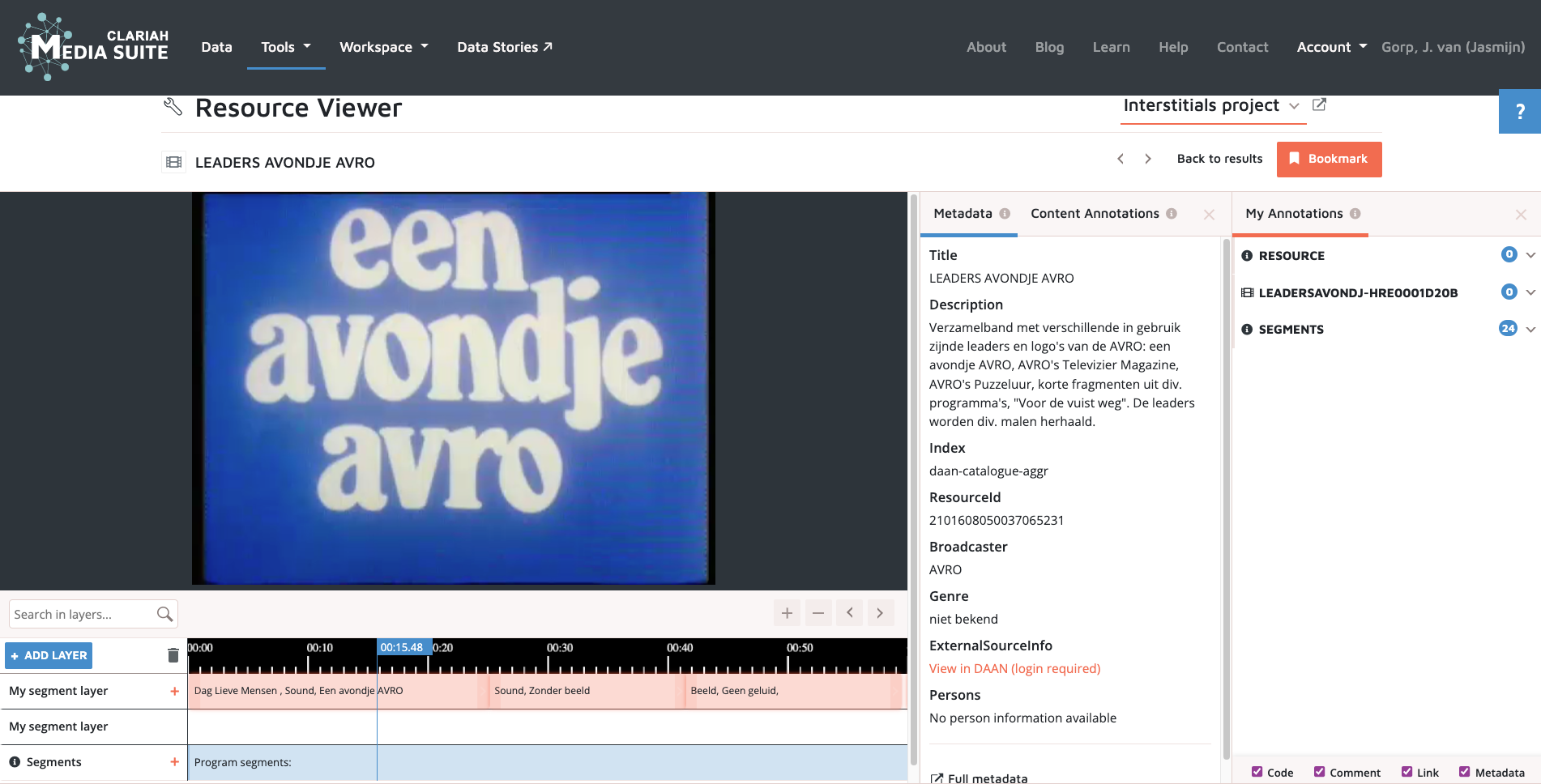
Screenshot Leaders Avondje AVRO (AVRO, 1975): link to video (login required)
As I explain in my chapter, the key in understanding the different genre categories by the archive is the GTAA, the General Thesaurus for Audiovisual Archives. The GTAA is accessible via the Resource Viewer of a random item (e.g. this one ), and My Annotations > Resource > Code > Vocabulary > select GTAA. The GTAA has one entry for Leaders, two for Promos, and five for commercials - my next category of interstitials.
Category 2: Commercials
As my research has shown (Van Gorp, 2022), commercials are the sole category of interstitials easy to find, as they are ascribed a separate genre-category and are often on display in programme titles. However, in comparison with the genre category of news archival commercials are still relatively rare. This archival focus on commercials can be explained by their popularity among general audiences and, thus in the Broadcast Museum. In her overview of Dutch commercials, Biernawski (2017) confirms this archival re-use value by referring to the audiences’ nostalgic feelings when watching commercials. In addition, Dutch public broadcasters have a very strong brand for the commercials’ block, STER, which is personalized by the very popular Loekie The Lion.
The most effective search route to commercials is to filter on genre commercials and videos. This search act leads to more than 77.000 results . When plotting a timeline, a peak in 2005 with almost 5000 commercials becomes apparent followed by a drop from the year 2008 (with only a few commercials per year). This probably has to do with copyrights. [4]
It also becomes apparent that many of the commercials, along with all interstitials, are part of a collection band (<Verzamelband). Thus, another search route to commercials is filtering on ‘collection band’ and genre ‘commercial’. Doing so leads to six items of which five items are ‘commercials database’ and one item is ‘ster reclame’. For my playlist I select the STER reclame on Duyvis Tigre Nuts with Gerard Cox* , which is also part of the Broadcast Museum’s collection. Gerard Cox is a famous comedian, singer and actor in the Netherlands. This commercial was very well-known for its one-liner “Duyvis is where the party is (<Duyvis, als er een fuif is).
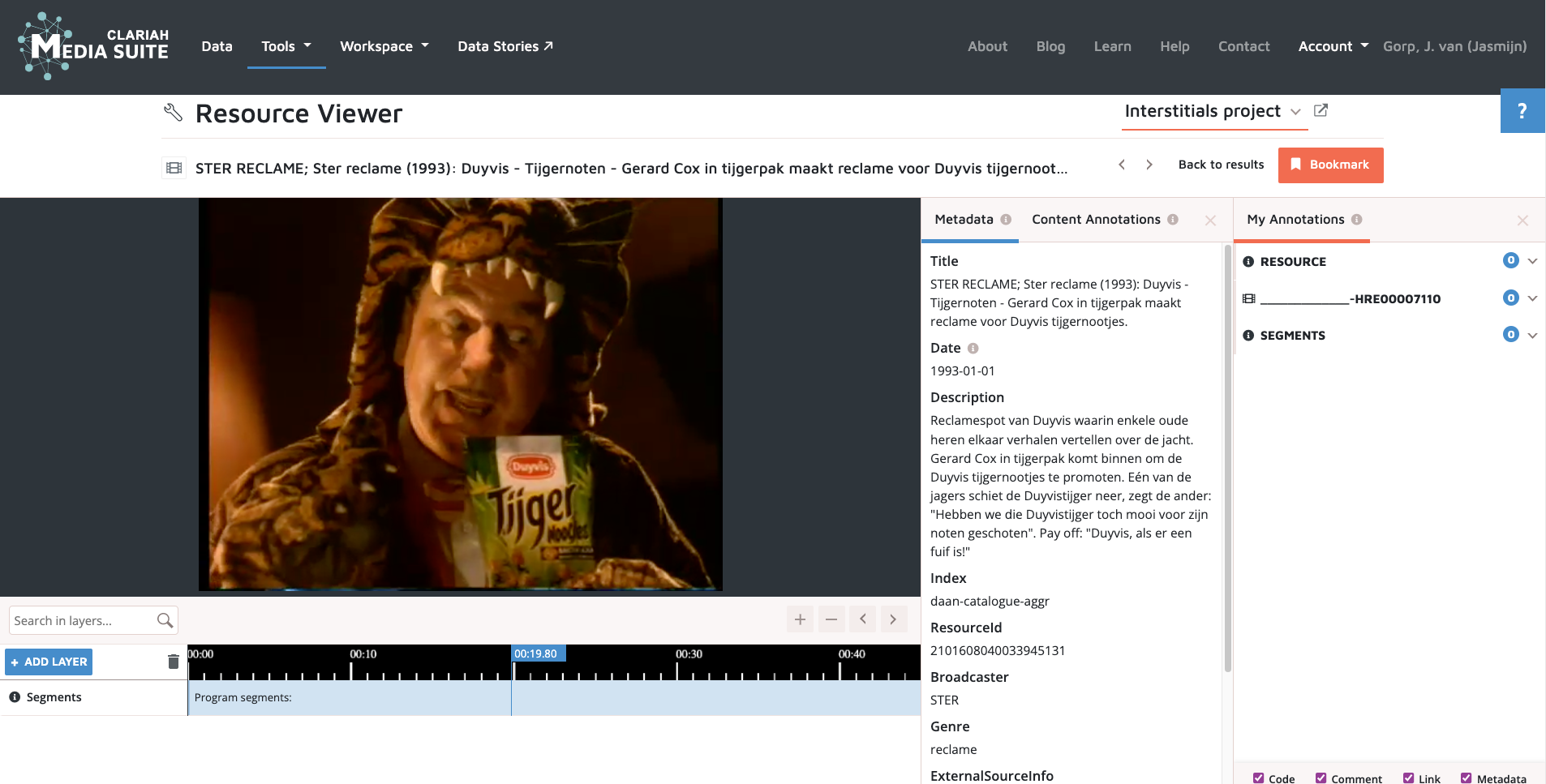
Screenshot Ster reclame Duyvis (Ster, 1993): link to video* (login required)
To get to a good cross-section of the collection, I decided to additionally select an infomercial: the in the Netherlands well-known Postbus 51. There are more than 4000 Postbus 51’s in the archive’s collection. This mostly encompasses Dutch government-commissioned infomercials/videos for societal public health and safety prevention purposes. Almost all Postbus 51 advertisements are closed off for viewing in the Media Suite, with some exceptions, such as the one below in the form of a compilation tape of commercials from 1990 . The tape e.g. consists of infomercials to prevent alcohol abuse and smoking, as well as to inform audiences about the risks of HIV/Aids.
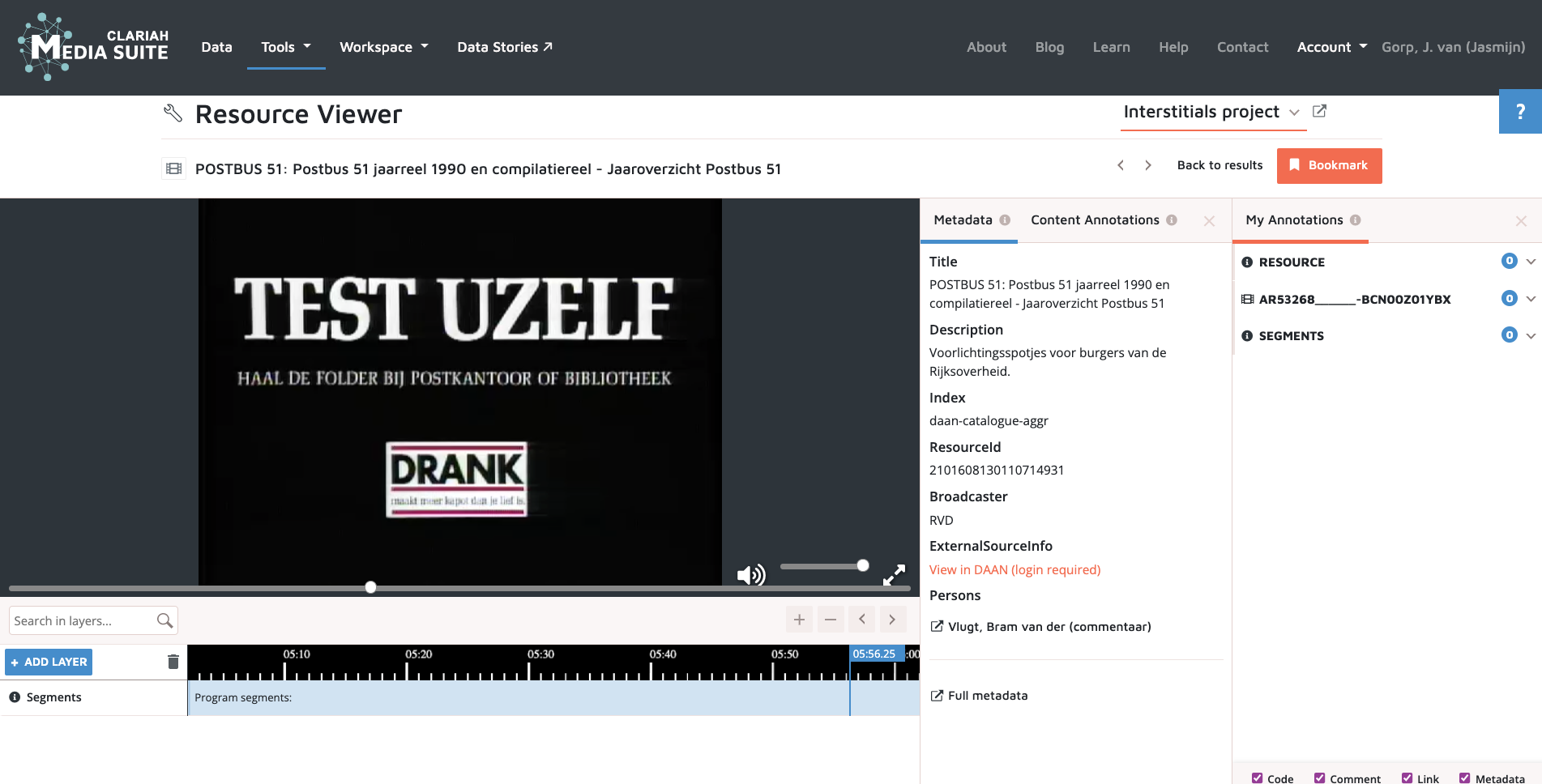
Screenshot Postbus 51 overview of the year 1990 (RVD, 1990): link to video (login required)
Finally, I deemed it interesting to probe the impact of commercials along with their viewing rates in order to gauge their popularity. As explained in the Viewing Rates Tutorial , two different reports of viewing rates reports are available until 1994: one for programmes and one for advertisements (and none for other types of interstitials). I intended to focus on the rates of the above Duyvis Tigre Nuts commercial. Yet most of the commercials in the archive are devoid of specific dates. In almost all cases the date is by default set on the first of January, since the exact first broadcast date is unknown. This practice hinders the tracing of viewing rates for commercials.
Category 3: Programme Announcements
A third category of interstitials that I have distinguished in my research encompass Programme Announcements. The latter form of interstitials are traditionally carried out by continuity announcers, either on view (in full or in medium close-up) or as voice-over. I have distinguished three ways to retrieve aforementioned programme announcements: blocks of television, weekly recordings and broadcasts about Interstitials.
Blocks of television are commonly known in the context of children’s television. It is a block of about 4 hours with different programmes that make up one show, often with a (voice-over) announcer who introduces each separate programme. To arrive at these television blocks, I queried for announcements in all fields and filter for genre ‘compilaties’ (compilations). This resulted in a list of 29 items , of which nine of KRO Kindertijd.
The television block KRO Kindertijd started in 1998, and continued as Kindertijd after the merger between KRO and NCRV in 2019. I notice that four of these shows contain exact the same announcement of a Klaas Vaak programme that starts on November 8th 2009: KRO Kindertijd 11 October , KRO Kindertijd 18 October , KRO Kindertijd 25 October and KRO Kindertijd 1 November . The announcement video -which can be considered as trailer- is in turn also announced at the very start of the television block. Approximately around 00:00:30 a young boy says “Later on you can watch the clip of Klaas Vaak” (<Straks kun je kijken naar de clip van Klaas Vaak) with an insert of the clip of 2 seconds. The trailer itself is played in full around 00:26:00. Exactly the same is done during four consecutive weeks. Interestingly, I found a fifth duplicate by searching for Klaas Vaak in title , which is the original trailer in which it is called ‘promoclip’ in its description.
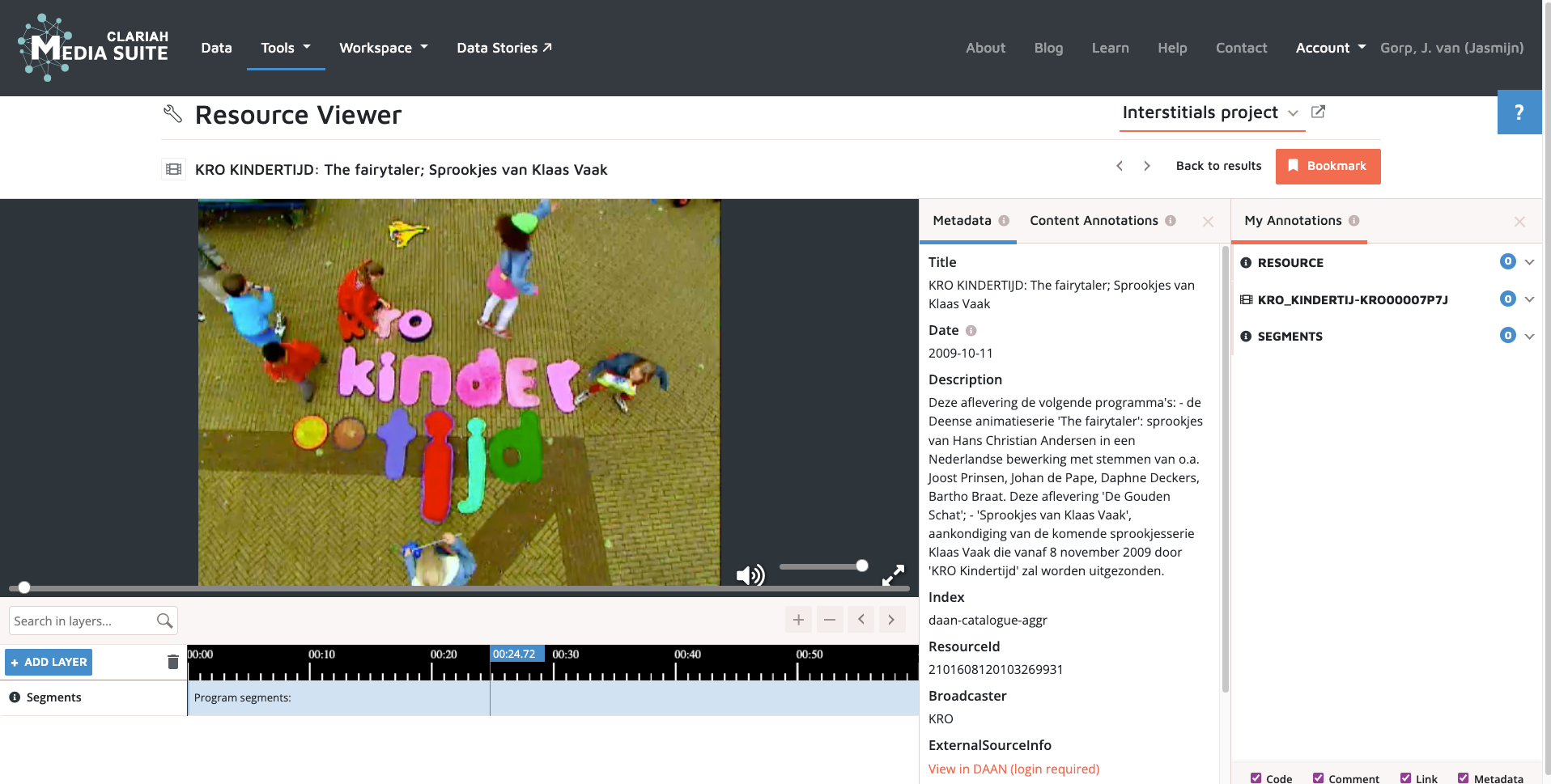
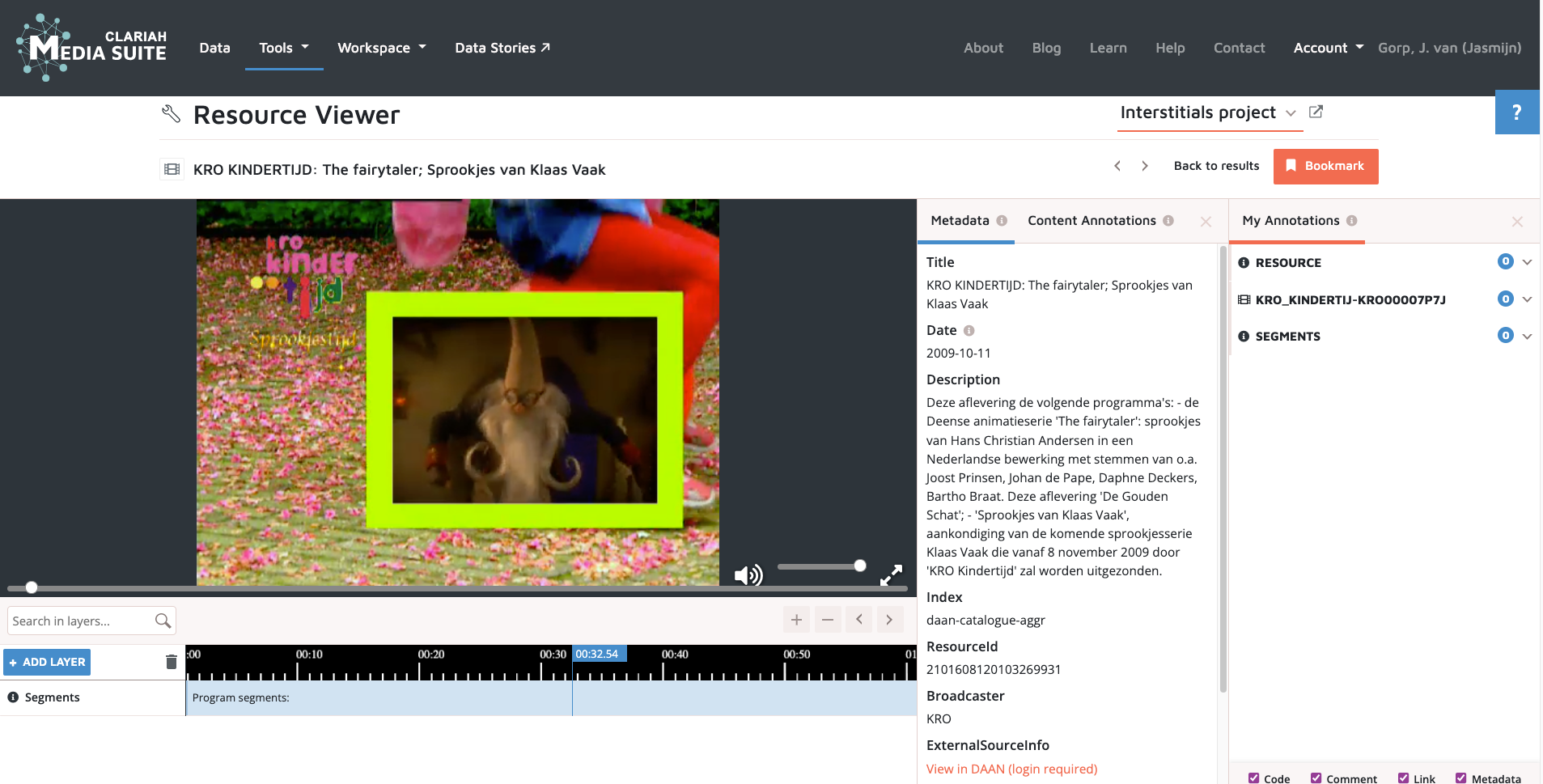
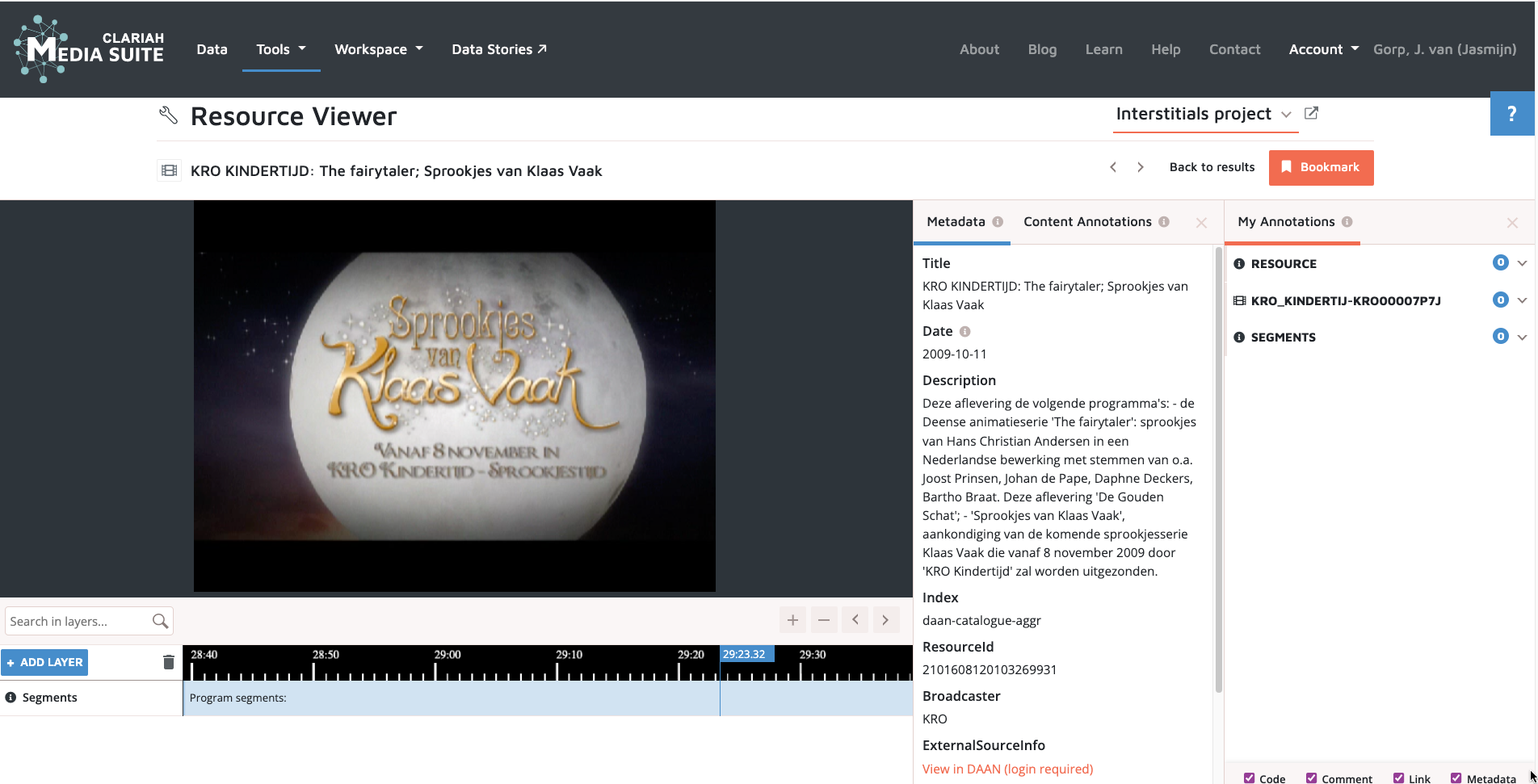
Screenshots of the television block ident KRO Kindertijd (top image), the announcement of the trailer of Klaas Vaak (middle image) and the actual trailer of Klaas Vaak (bottom image) (KRO, 2009): link to video (login required)*
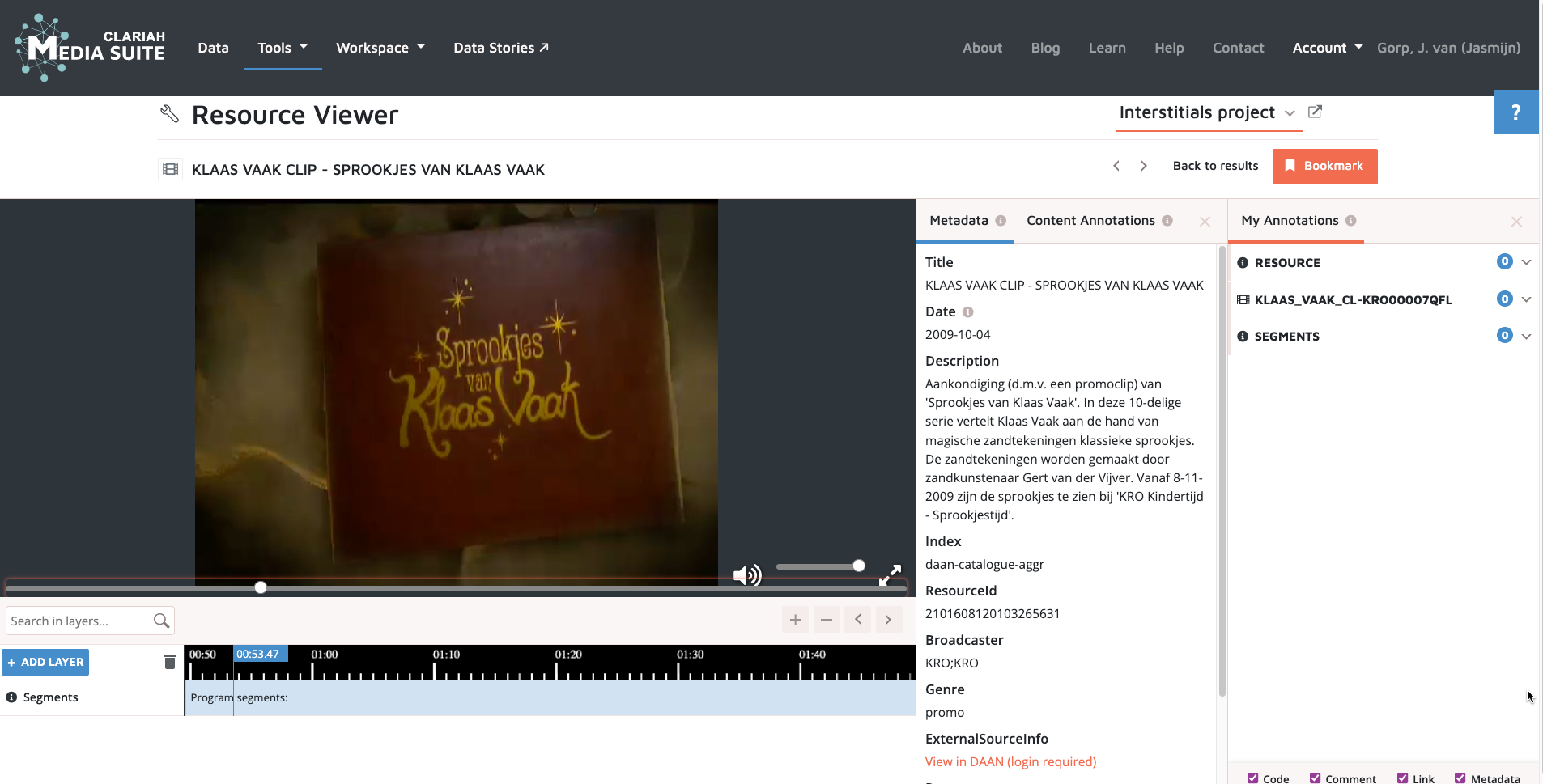
Screenshot Klaas Vaak Clip (KRO, 2009): link to video (login required)*
In the same search I also accidently found a fake interstitial: a programme announcement for a Film Noir* of the comedy show Jiskefet. As I explain in my chapter (Van Gorp, 2022), I was puzzled by this search result at first, as the metadata description was written in the same format as real announcements. In this fake interstitial a voice-over announces the non-existing film La Pluie Sans Droit of the French filmmaker Jean-Philippe Le Grain, which will be broadcast the upcoming Saturday on VPRO Cinema. It was also announced in a similar vein as a real film on the Jiskefet Facebook page.
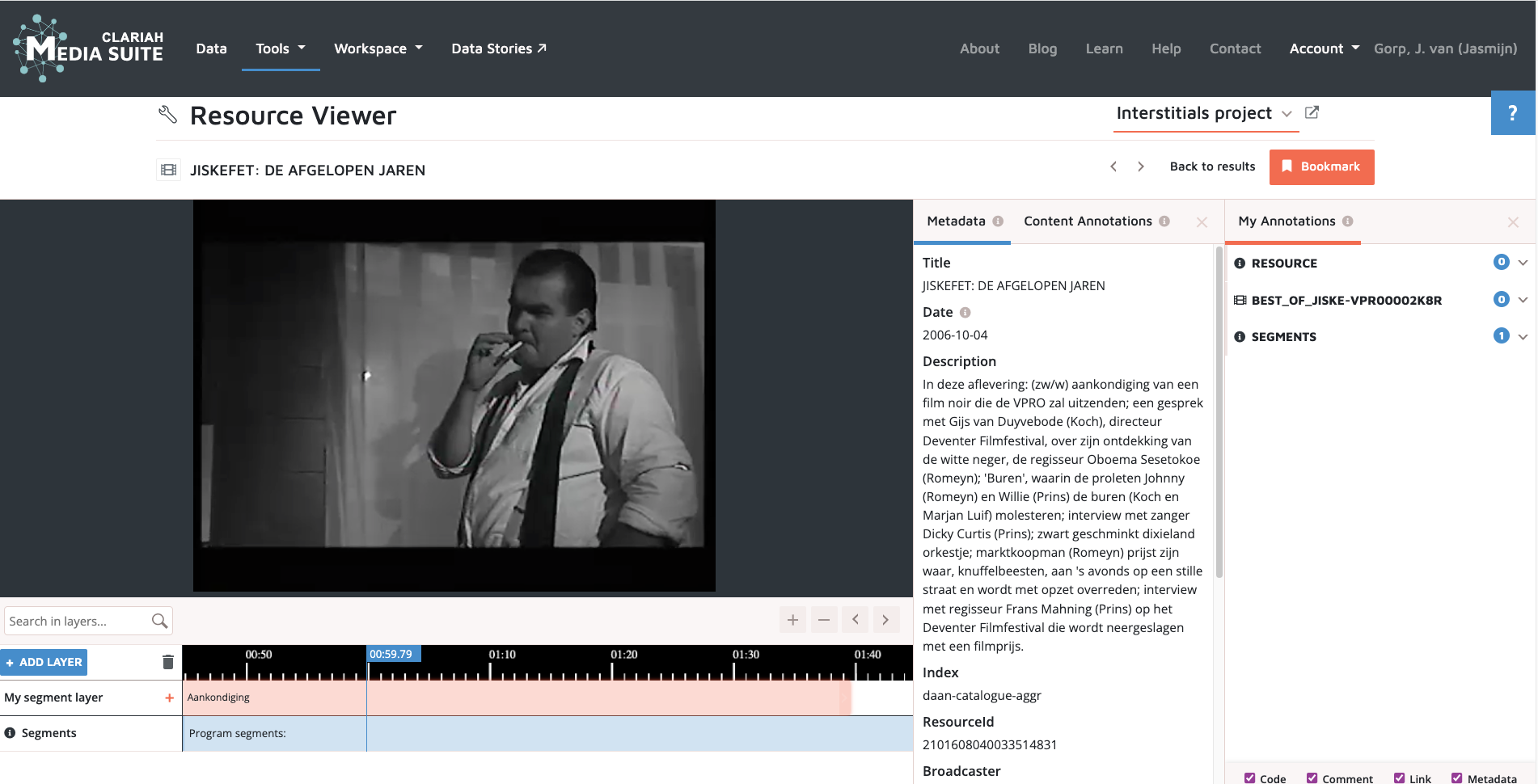
Screenshot Jiskefet Film Noir announcement (VPRO, 2006): link to video * (login required)
A specific type of announcements are “Public Service Announcements”. When I queried them I only retrieve videos with speech transcripts, in which the announcer uses the word ‘Service announcement’ (<Dienstmededeling). These are not visual interstitials but instead textual interstitials within (instead of between) programmes. An interesting one is this announcement of the presenter in Brandpunt that carries a rectification of a previous announcement by Henny Huisman in The Soundmix Show, correcting a mistake made in Teletext Page numbers: “This is a service announcement. […] The phone numbers of The Soundmix Show can not be found on page 199 of Teletext but on page 335”.
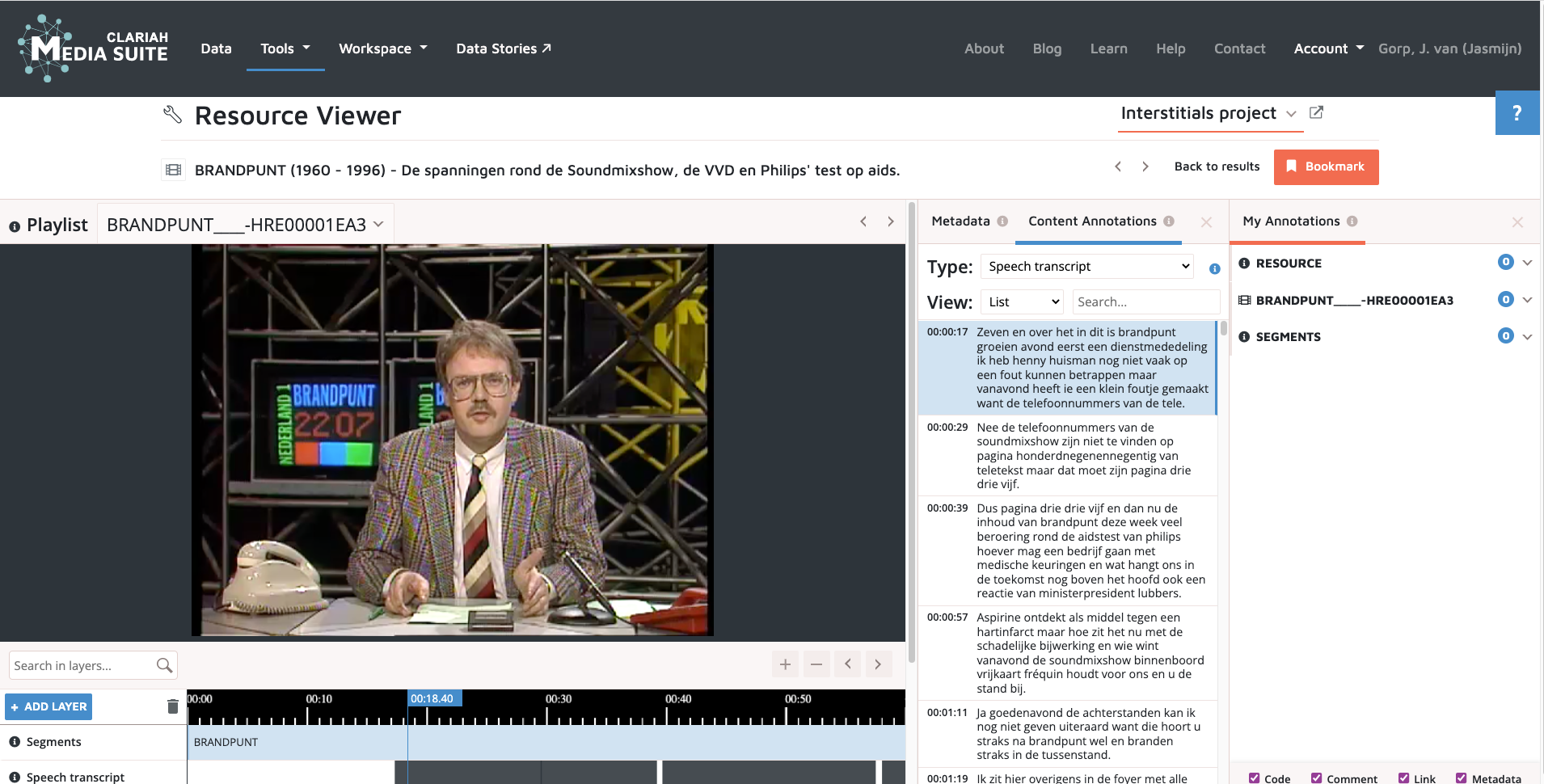
Screenshot of service announcement in Brandpunt (KRO, 1988): link to video (login required)
Category 4: Weekly Recordings
Johnson (2009) used Weekly recordings for her research. Weekly recordings are full day recordings of the entire 24h broadcast-cycle of one channel. NISV also stores these kinds of Weekly recordings of two weeks per year, for each channel from 1987. The best way to reach this subcollection is to conduct a search query for “Integral Recordings” and “Week” which results in about 3032 recordings, of which most can not be played in the Media Suite. The findings also contain recordings of the commercial broadcasters.
For my curated playlist I select a weekend-day (a Sunday), along with the first broadcaster, Nederland 1: NED 1: WEEK 40-1999 1.10.1999 . I watched the first reel and noted all interstitials and their categorization type (see overview, table 1). This shows that during a time period of two hours almost 44 interstitials were shown, which were all left out of the title of the record, the description and of the programme schedule in the newspaper. This alone proves my point earlier made that interstitials are -not only academically but also quite literally - forgettable television.

Screenshot of AVRO ident within Weekly Recording of channel NEDERLAND 1 (1.10.1999): link to video* (login required)
The weekly recordings are also useful in providing insight in the prevalence of repetition within the domain of interstitials. The programme Spoorloos is announced twice in two hours, of which the first announcement in slow motion and the second announcement at normal speed. The commercial for Vichy is also repeated twice in the same commercial break, the first in long version and the second in short version. The idents for the channel -in this case Nederland 1- are always shown right before the ident of the broadcaster of the following program. The commercial break is not announced with a channel ident, but instead with a separate commercial break announcement of Loekie the Lion. As I explain in my chapter I tried to retrieve the original programmes as well, to no avail. The weekly recordings are albeit of utmost importance for media history, and they are key to fully comprehending television flows in the past. As William Uricchio (2009: 30) explains regarding the importance of ephemeral media: “It helps to account for the variable status of a particular shot or program, and for the embedding of ever shifting bits of recorded time into new contexts.”
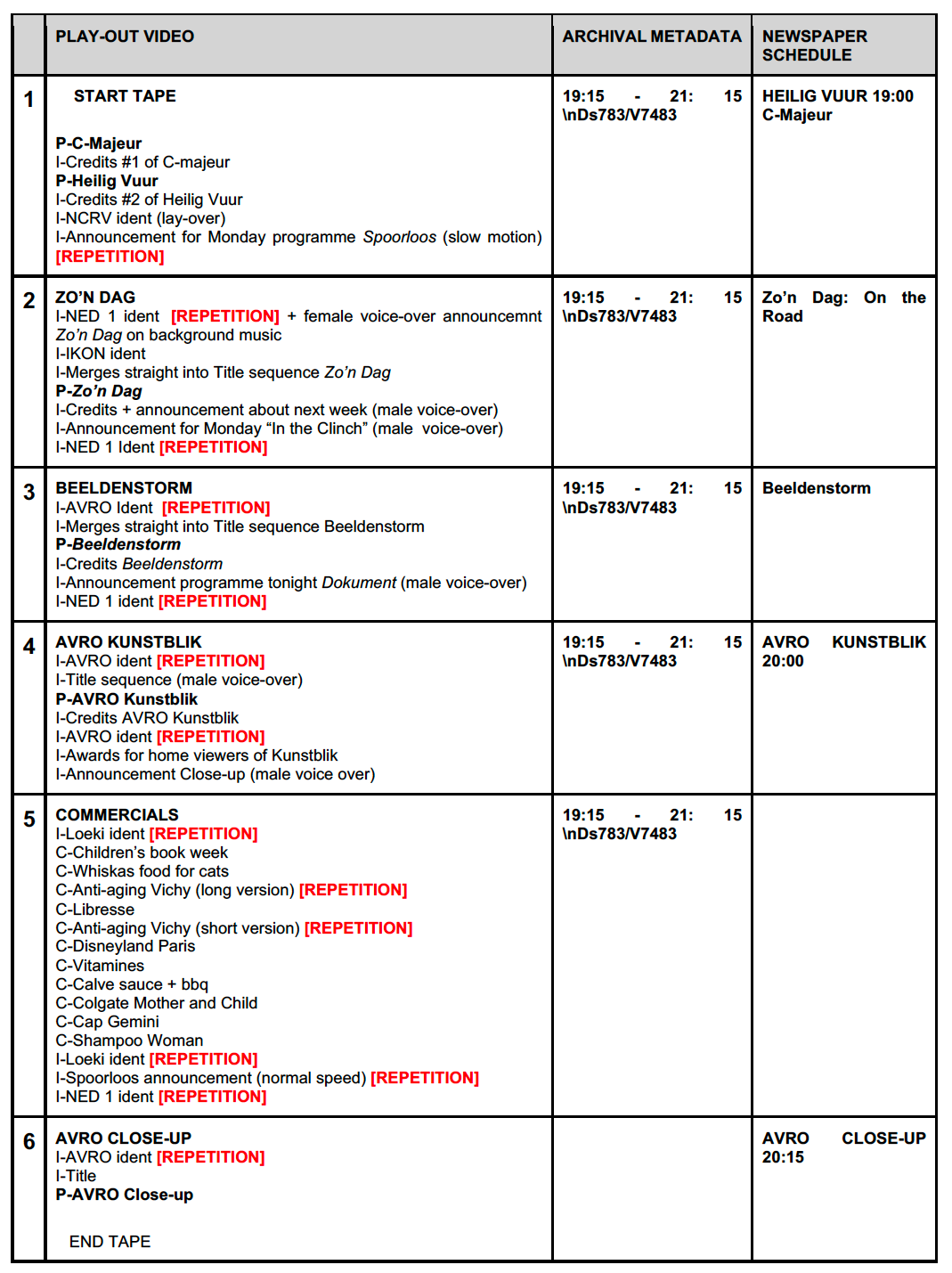
Table 1: Annotated content of the first available reel of the weekly recording of 10 October 1999 for NPO 1 (left column) compared to its metadata field Annotation (middle column) and the time schedule taken from newspaper Leidsche Courant (right column)
Category 5: Broadcasts About Interstitials
At a meta-level the archive finally contains broadcasts about interstitials. These shows provide an interesting view on the history of television history. Andere Tijden is a well-known programme that regularly includes topics related to media and television. They aired an episode on 40 Years of STER commercials in 2007. As a small side note: thanks to this episode it was brought to my attention that Jiskefet also created a series about Multilul , a fake advertising agency that is brainstorming about new leaders for Loekie the Lion .
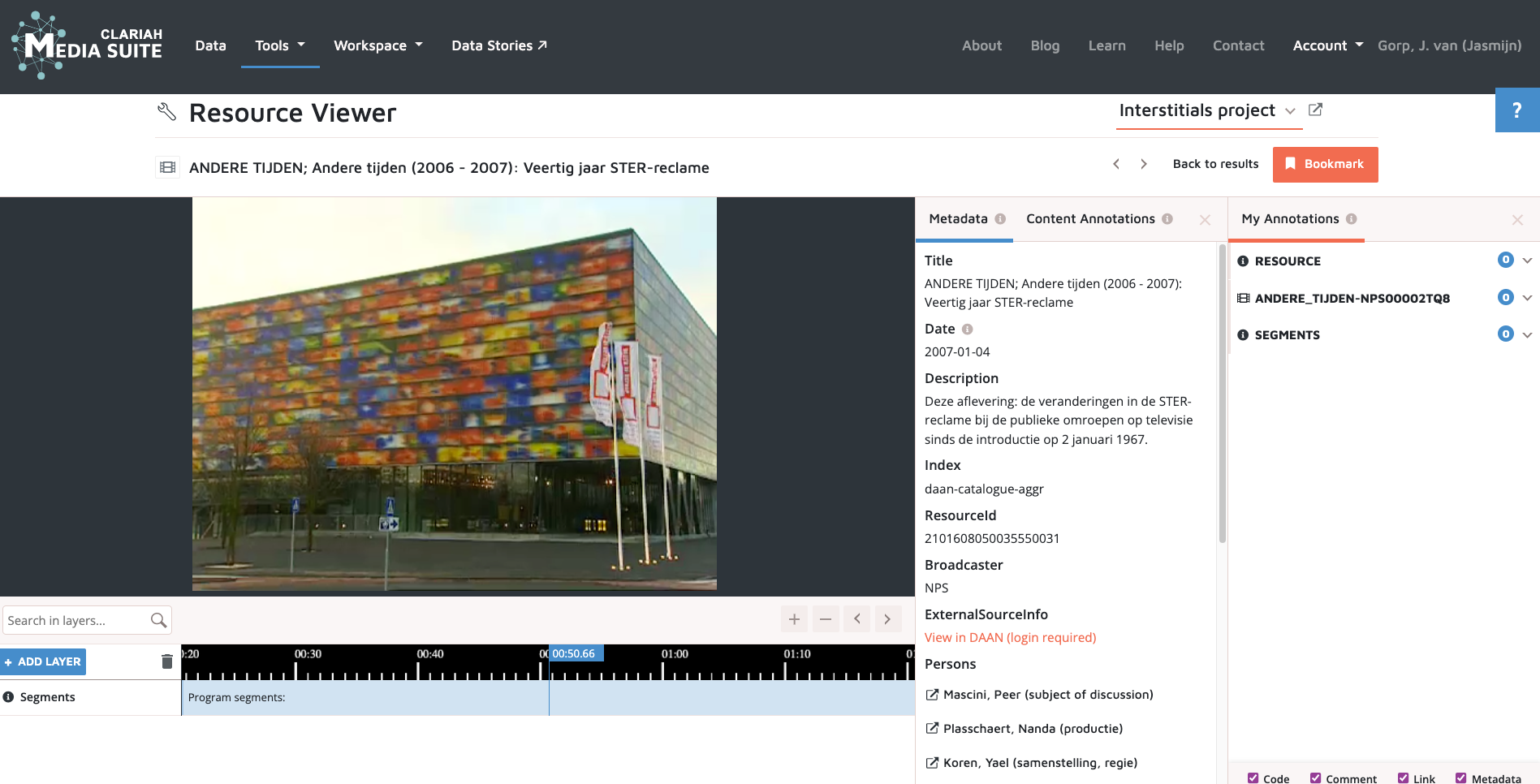
Screenshot Andere Tijden Veertig jaar Ster-reclame (NPS, 2007): link to video (login required)
TV Monument by Han Peekel is another programme about television which got broadcasted on the theme channel BEST24. The TV Monument series contains an episode with the continuity announcer Dieuwertje Blok , an episode on Radio and TV-Music in which the music of commercials is discussed around 00:18:00 and a programme on Dutch continuity announcers .
For my curated playlist, I select the latter, which is based on oral history interviews with female announcers. Similar to the VPRO Tegenlicht episode, the presenter and the show are aired from inside the building of the Netherlands Institute for Sound and Vision, which immediately positions the archive also as the location-to-be for television historical broadcasts.
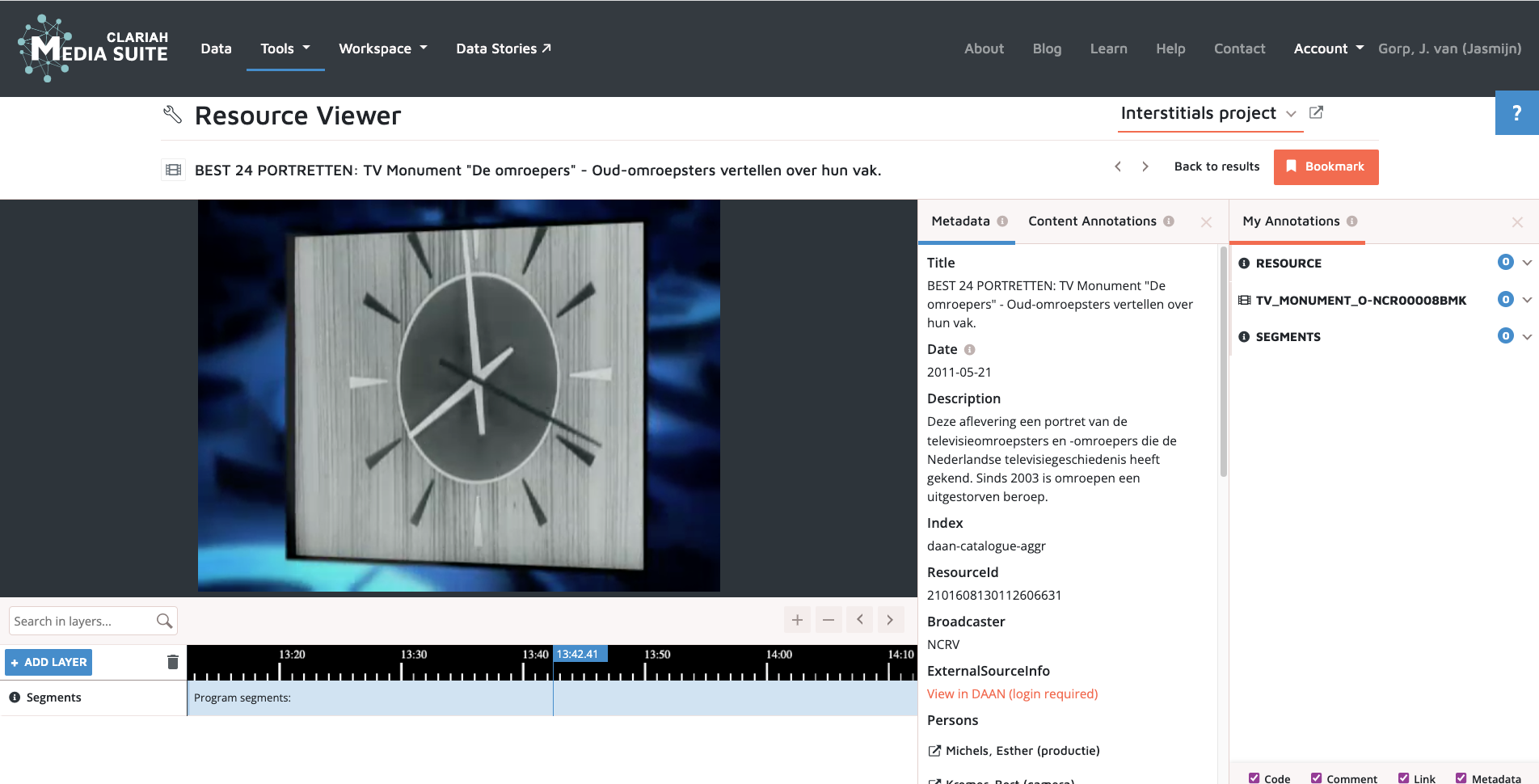
Screenshot TV Monument: Continuity Announcers (NCRV, 2011): link to video (login required)
The interesting segments in this episode are: 00:06:18 Historian René Koenders explains that announcers were necessary for the viewers to explain what they are looking at, but also for the technicians to prepare for the next program. 00:27:41 Diewertje Blok explains that she was just repeating what was in the programme guide 00:31:30 Han Pekel is recounting how announcers should fit the identity and brand of the broadcaster and its pillar
The programme noticeably starts with raw footage of an announcer. This raw footage is cropped from all videos that are accessible via the Media Suite. The best way to get a glimpse on announcers within the Media Suite are the Weekly recordings.
In sum, my curated playlist has highlighted the different categories of interstitials and (the challenges in) how to find and analyze them, against the background of the Media Suite search tool. My overview is not exhaustive, but shows possible pathways to arrive at some fascinating interstitials. Future research could probe the field of interstitials more in-depth, as to give them the credit they deserve as a sub-field of study within current and future media scholarship and debates.
References
-
Biernawska, K. (2017). TV Commercials’ Second Life: Commercials as Remembrance Culture in the Netherlands. VIEW Journal of European Television History and Culture, 6(11), 41–52. https://doi.org/10.18146/2213-0969.2017.jethc122
-
Ellis, J. (2011). “Interstitials: How the ‘Bits in Between’ Define the Programmes.” In Ephemeral Media: Transitory Screen Culture from Television to YouTube, edited by Paul Grainge, 59-69. London: Palgrave Macmillan.
-
Johnson, C. (2012). Branding Television. Abingdon: Routledge.
-
Polan, D. (2013). It’s fun to eat: Forgotten television. In E. Thompson & J. Mittel, How to Watch Television (pp. 347–354). New York University Press.
-
Uricchio, W. (2011). The recurrent, the recombinatory and the ephemeral. In Ephemeral Media: Transitory Screen Culture from Television to YouTube , edited by Paul Grainge,, 23–36. London: Palgrave Macmillan.
-
Van Gorp, J. (2023) Interstitial Data: Tracing Metadata in Archival Search Systems. In van Es, K. & Verhoeff, N. (eds.) Situating Data: An Inquiry in Algorithmic Culture . Amsterdam: Amsterdam University Press. Pp. 207-222.
End notes
[1] In my experience, the “Sound and Vision Collection” is more complete for television than the separate “Television Collection”. To exclude radio records from the “Sound and Vision Collection”, I exclude “audio” in the facet “MediaType”. [2] To learn more about my specific selection criteria, I refer to my book chapter. [3] For an overview of BBC idents, for instance, I refer to this webpage about ‘The Story of BBC Television’. [4] In terms of copyright, commercials are often a difficult case, as the commissioner, the owners of the product that is advertised, often hold the copyrights.